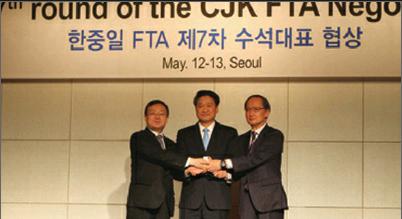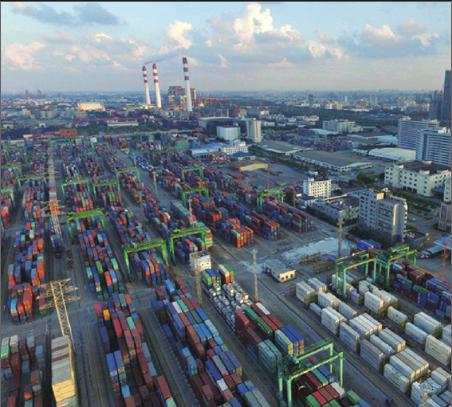FEAR NOT,GET BACK TO WORK
2015-11-05ByZhouXiaoyan
By+Zhou+Xiaoyan


After years of intensive negotiations, trade ministers of the United States and 11 other Pacific Rim countries successfully concluded the Trans-Pacific Partnership (TPP) free trade talks on October 5, marking a pivotal step toward the pact that is aimed at reshaping trade rules in the Asia-Pacific region.
The TPP talks currently involve 12 countries—the United States, Japan, Australia, Canada, Singapore, Brunei, Malaysia, Viet Nam, New Zealand, Chile, Mexico and Peru, encompassing 40 percent of the world economy. Believed to be the biggest trade agreement in the world, its aim is to help lower trade barriers and increase investment between those countries.
China, the worlds second largest economy and the leading economic powerhouse in Asia, was not invited to participate in the negotiations, raising concerns domestically that being excluded from the TPP would cause the country to be marginalized in international trade.
Li Jian, Director of the Institute of International Trade at the Chinese Academy of International Trade and Economic Cooperation (CAITEC), however, said that the trade pact will have a limited impact on China. Li explained that the country has been taking countermeasures since negotiations over the TPP first started in March 2010, as evidenced by the fact that China has signed 14 free trade agreements (FTAs) with 22 countries and regions to date, including eight out of the 12 TPP members.
In the meantime, Li said the trade pact is not specifically aimed at containing China.
“The reason why the United States is leading the TPP trade talks is because it wants to create a set of rules wherein it can get the most out of its position as the worlds largest economy against the background of its declining competitive edge in the current global trading system,” Li told Beijing Review.
“Although the trade pact does help the United States cope with a rising China thats increasingly threatening Americas dominance on the world stage, the ultimate purpose of the trade pact is to consolidate U.S. advantage in global trade under the new circumstances and improve its own economy,” Li said.
On October 8, Chinas Minister of Commerce Gao Hucheng said that the country will comprehensively and systematically assess the TPP and that changes in global trade patterns will ultimately be decided by industrial structure adjustments and product competitiveness in international markets.
According to Gao, China sees the TPP as one of many free trade agreements for the Asia-Pacific region and is open to any mechanism that follows rules of the World Trade Organization (WTO) and can boost the economic integration of the AsiaPacific.
“China will maintain its reform and openingup policy and unswervingly support global economic integration and the multilateral trading system,” he said.
Observers like Li say that, in todays world, no power can really isolate China. To offset any negative impact as a result of the TPP as currently constructed, Chinas actions should be twofold—accelerate its reform and opening up and develop its free trade zones at home and abroad. China should concentrate its energy on its own business. If it follows this plan of action, the country has nothing to worry about.
The TPP explained
The TPP was originally initiated by Chile, Singapore, New Zealand and Brunei in 2005, featuring the elimination of tariffs among member economies. In 2008, with the participation of the United States, the TPP gained more focus and later recruited other members.
The pact covers a range of legal provisions, including investment, service, electronic commerce, government procurement, intellectual property and the environment. The agreement will allow for greater market exposure, as up to 18,000 kinds of tariffs are to be reduced or eliminated under the terms of the TPP.
While the TPP does not challenge the WTO, Zhang Yansheng, Secretary General of the Academic Committee of the National Development and Reform Commission (NDRC), explained that there are several distinctions to be made between the TPP and the WTO constructs.
“First, the level of trade liberalization among TPP members is higher than that among WTO members, as the WTO implements a low-tariff policy, while 90 percent of all goods tariffs will be immediately canceled among TPP members and other tariffs will be gradually canceled within 12 years,” he explained.
“Second, its a set of higher-standard trade rules than the WTO in that its coverage goes far beyond trade and investment to areas including environmental protection, labor protection, intellectual property rights, government purchases, green growth and competition policies,”Zhang added.
Remaining questions
Although the trade talks between the negotiators have been concluded, the deal still faces several challenges before it could go into force.
First, the deal still needs to be wholly ratified, which could be difficult depending on the political situation in each of the 12 countries.
Market access to agricultural products, the country-of-origin rule in the auto manufacturing industry, and intellectual property protection within the pharmaceutical industry have been monumental sticking points throughout the negotiations.
For example, in the United States, several Republican and Democratic presidential candidates, including Democratic presidential frontrunner Hillary Clinton, have begun attacking the TPP amid widespread concerns over potential job losses. Trade unions, environmental groups, consumer and healthcare organizations across the country have come together to organize protests against the TPP.
Second, the TPP can create a greater imbalance of developed and developing member states. Some experts have voiced concerns that the TPP will not complement the development stage of the participating emerging economies.
According to Li at the CAITEC, developing countries involved in the TPP talks, such as Mexico and Viet Nam, should prepare their economies for any potential impact from the TPP.
“Although a detailed text of the TPP has yet to be released, I believe it will set a buffer period for developing countries so that they can adjust their domestic policies and industries to adapt to the trade pact,” Li said.
“Developing countries involved in the TPP talks should make strenuous efforts in this regard. If they fail to do so, they wont be able to enjoy some of the benefits of the TPP because of their lagging technologies and services. In the meantime, the TPP is requiring them to open their domestic markets. That will pose a great challenge to their economies,” Li cautioned.
Impact on China
Some observers say the TPP will have a negative impact on Chinas foreign trade and the broader economy at large, as the zero-tariff policy among TPP members will eat into the global market share of Chinese exports.
Zhang Jianping, a senior researcher with the Institute for International Economic Research under the NDRC, said lower tariffs will make products from TPP members more competitive in other members markets.
For instance, after the tariff reduction, textile and apparel products from Viet Nam could end up costing less in the U.S. market than their Chinese counterparts, while electronic and machinery products from Malaysia and Japan could replace those from China, Zhang elaborated.
According to Ma Jun, chief economist of the Peoples Bank of China, the countrys central bank, China would lose 2.2 percent of its GDP if excluded from a 15-member TPP.
The 2.2-percent drop was arrived at based on the gap between the net effects of two different scenarios—one that assumes 16 nations, including China, joined the TPP; the other that assumes 15 nations, including the current 12 nations plus South Korea, Indonesia and Thailand, joined the group, according to an academic paper published by Ma in Shanghai Securities Journal.

However, more experts tend to agree that the TPP deal will have a limited impact on China because the country is able to cushion the negative impact by inking bilateral trade agreements with countries, including many TPP members.
Chen Fengying, a senior researcher at the China Institutes of Contemporary International Relations, ruled out the possibility of China being isolated by the TPP trade pact.
“Right now, its impossible for any country to isolate China. With a GDP valued at $10 trillion, China is now the worlds largest goods trading nation and has evolved into a vast market fueled by enormous domestic demand. How can any country isolate China?”Chen reasoned.
According to Chinas Minister of Commerce, China is now the largest trading partner for over 120 countries in the world. Of the current 12 TPP members, eight of them have signed FTAs with China—Chile, Peru, Australia, New Zealand and the four ASEAN member states—to a large extent offsetting the impact of TPP even without TPP membership.
Domestically, China has established four free trade zones in Shanghai, Tianjin, Guangdong Province and Fujian Province, which adopted the negative list and pre-establishment national treatment for foreign investment, both in conformity with requirements from the TPP and the BIT (bilateral investment treaty).
China is continuing its efforts to seek additional agreements with several of its leading trading partners, including: the China-Japan-South Korea FTA talks; a revitalized China-ASEAN FTA; and negotiations over Regional Comprehensive Economic Partnership (RCEP)—a proposed FTA between the ASEAN and the six states with which ASEAN has existing FTAs (Australia, China, India, Japan, South Korea and New Zealand).
Separately, China is accelerating negotiations over a BIT with the United States.
“All these countermeasures will help balance out the negative impact of being excluded from the TPP,” Li from the CAITEC, told Beijing Review. “They are also preparing the country for higher-standard FTAs in the future.”
Li expects China will join the TPP in the future.
“Currently, the TPP only has 12 members. It needs to be expanded and needs to accept new members,” Li said. “The United States needs China, and the two countries have a lot to work together on. Excluding China from the TPP would hurt China a little bit but will cost the United States plenty of development opportunities as well.”
Li said China should use the TPP as a driving force for further reform and opening up.
According to Li, China owes a great deal of its rapid expansion over the past three decades to the opening of its economy to the world. He believes that the current level of reform can serve the demands of a country that has preliminarily realized industrialization, but China needs further modernization in the post-industrialization era. The country, in other words, needs a freer and fairer busi- ness environment.
“China is not ready to join the TPP now, but its a direction in which the country should travel by bolstering reforms and opening up,” Li said. “That will help China realize sustainable development in the next three decades after three decades of rapid development.”
“In a sense, the TPP is not only a challenge for China but also an incentive and a goal the country can work hard for,” Li concluded.
